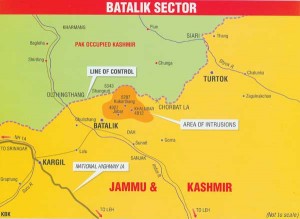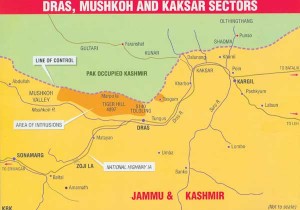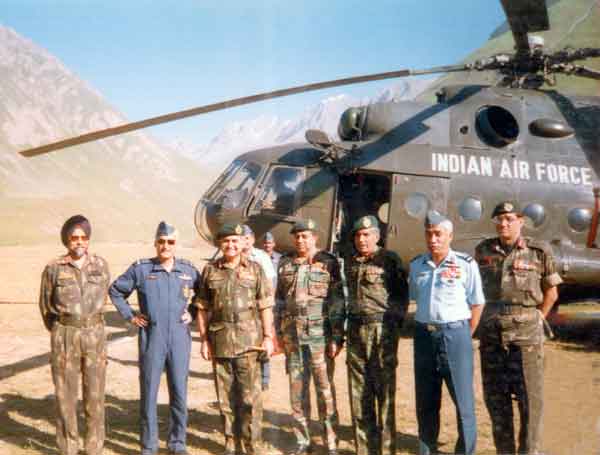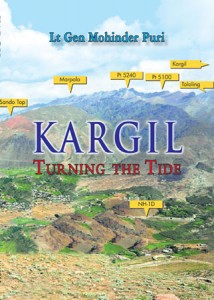It was the 12th of June 1999. Eleven days had passed since 8 Mountain Division (Mtn Div) of which, I was privileged to be the General Officer Commanding (GOC), had assumed operational responsibility of the Drass-Mushkoh sectors from the local formation. My Div was deployed in the Srinagar Valley since 1989 when Gen Malik, later the Chief of the Army Staff (COAS) during the Kargil War, had moved it from Nagaland . We had brought the insurgency under control in the valley and were now inducted in the Kargil sector to restore the situation in Drass.
At the strategic level, besides embarrassing India, Pakistan’s aim was to internationalise the Kashmir issue, as it was losing its grip in the valley and had to do something sensational to bring the issue to international centre stage.
Thanks to the media, Tololing had become a household name and had defied capture for the better part of three weeks. 18 Grenadiers was in contact with the enemy but unfortunately and due to no fault of theirs, were unsuccessful in overcoming the opposition. The battalion, a part of 8 Mtn Div had moved into the Drass sector with 56 Mountain Brigade, its parent formation, along with 8 Sikh and 1 Naga in mid-May 99. 1 Bihar also a part of the brigade had been placed under 70 Infantry Brigade of 3 Infantry Division (Inf Div) in the Batalik sector.
The situation by the time my Div was given charge of the Drass sector was tense. Since mid-May we had not met with any success. Casualties were mounting and there was a discernible impression that Pak was having the better of us. To say that we were surprised would be an understatement. The fog of war was taking a heavy toll on troops who were fighting in the most inhospitable terrains with shortage of weapons and equipment. It was in this background that my formation was moved across the Zojila after deinducting from the counter-insurgency grid in the valley.Our orientation was directed towards fighting insurgency and suddenly with the developments in Kargil, we had to quickly change gear to meet the conventional threat from Pak. The record of the Div in the valley was noteworthy and we had earned a name for ourselves and established a good rapport with the local population. The decision to move the formation for the Kargil operations was a difficult one. While 8 Mtn Div was the Command reserve, moving it from the valley created a vacuum and the Rashtriya Rifles formations took some time to restore the situation.
The timing of the Pak intrusion was intriguing and perhaps was the reason for its initial success, which took the Indian Army and the country by total surprise. The perfidy of launching an operation when efforts were being made after the Lahore summit to improve relations between the two sides should serve as a lesson regarding the degree of trust with which we must respond to peace overtures by our neighbour. At the strategic level, besides embarrassing India, Pakistan’s aim was to internationalise the Kashmir issue, as it was losing its grip in the valley and had to do something sensational to bring the issue to international centre stage.
Pak perceived that the political situation in India was fragile and in such an environment the Indian polity would not have the stomach to retaliate to any aggressive designs. Militarily, Pak selected areas for the intrusions which would offer minimum resistance and where they could exploit the large gaps in the defences. Also by launching such an operation, Pak aimed to secure maximum territory for strategic and tactical gains, change the status of the Line of Control (LoC), revive insurgency in the valley and elsewhere in J&K as well as isolate Ladakh from Srinagar. It was a highly ambitious plan and since it surprised the Indian Army, it met with tremendous initial success.
We had perfected the employment of the Bofor guns in the direct firing role. The effect of the firing was devastating and most encouraging for our troops.
However, at the strategic level there were many loopholes in the plan. To a trained military mind it appeared to be bereft of any consideration of the end result and the gains that would accrue. It was obviously not war gamed with a wider audience, perhaps due to the over zealousness to keep the proceedings restricted to a few confidantes. The fact that the Pak Corps commanders and the other two service Chiefs and the PM were kept out of the planning loop is itself indicative of the amateurishness in planning a major operation of this nature across the LoC.
The terrain in which the operations were conducted was rugged with precipitous slopes and heights varying from 18000-21000 ft. The inhospitable and daunting terrain took a heavy toll of men and material. The extreme high altitude made breathing difficult and movement sapped one’s energy. Our initial failure to evict the intrusions could well be attributed to lack of acclimatization of the troops. Ladakh was served from Srinagar by the highway to Leh which remained closed from end Nov till May due to heavy snow. The road was used during fair weather period for the logistic stocking for the military garrison and the local population of Leh which was indeed a Herculean task.
It was on heights dominating the highway that Pak infiltrators intruded and began to effectively interdict movement on the main road axis to Leh. The timing of the intrusion was hotly debated in the media and in military circles. While there were wild claims that the intrusions had occurred as early as Dec 1998, the stocks recovered by us from the captured posts and staff checks done by us gave ample indication of the intrusions having taken place sometime in end Feb/early Mar timeframe.It was on 27 May, 1999 early morning that I was summoned by the Corps Commander to accompany him, during his conduct of the Defence Minister and COAS to the Drass and Kargil sectors. The decision to either launch 8 or 6 Mtn Div had been under active consideration for sometime.
 The SWOT analysis was well balanced for either formation to take on the task of evicting the intruders from the Drass-Mushkoh sectors, but perhaps what weighed in favour of 8 Mtn Div was that it had been operating under 15 Corps ever since the early ‘90’s and was a part of the Corps. Also troops operating in insurgency ridden areas had been blooded in battle over the years and were better suited for an immediate response; albeit after a reorientation capsule for conventional operations.It was during this visit that the COAS called me aside at Drass and gave me the operational responsibility of evicting the intruders from Drass-Mushkoh sectors. I am also certain that the Corps Commander, Lt Gen Krishan Pal had the last word in recommending 8 Mtn Div for the task. I had mentioned two issues to the COAS; first that we should be prepared for casualties, and the second that there should be no haste in progressing operations. It is to the credit of the higher leadership that while at times pressure was exerted, which is natural in such an environment, there was no one breathing down my neck to hasten the operations.
The SWOT analysis was well balanced for either formation to take on the task of evicting the intruders from the Drass-Mushkoh sectors, but perhaps what weighed in favour of 8 Mtn Div was that it had been operating under 15 Corps ever since the early ‘90’s and was a part of the Corps. Also troops operating in insurgency ridden areas had been blooded in battle over the years and were better suited for an immediate response; albeit after a reorientation capsule for conventional operations.It was during this visit that the COAS called me aside at Drass and gave me the operational responsibility of evicting the intruders from Drass-Mushkoh sectors. I am also certain that the Corps Commander, Lt Gen Krishan Pal had the last word in recommending 8 Mtn Div for the task. I had mentioned two issues to the COAS; first that we should be prepared for casualties, and the second that there should be no haste in progressing operations. It is to the credit of the higher leadership that while at times pressure was exerted, which is natural in such an environment, there was no one breathing down my neck to hasten the operations.
Employment of air per se was a morale raising factor for our troops and conversely it had an adverse effect on the enemy. But its effectiveness was questionable.
Pak intruders had established a large number of posts on heights dominating the national highway and Mushkoh Valley. Unfortunately for Pak, the highway opened in early May, mainly due to a lighter snowfall in the winters and efforts of the Border Road Organisation. Nevertheless, the intruders effectively dominated the road and made vehicular movement difficult during daytime. The enemy was well armed and depended more on fire power than manpower. With automatic weapons, it had covered all the important nalas, ridges as well as supply routes leading onto his positions. From these positions, it sent out small parties to engage any movement of our patrols dispatched to gain information of its location, defences or troops attempting to capture the posts. The defences were well sited and coordinated, and control of fire including illumination plan was very effective.
The enemy’s minor tactics of firing and quickly shifting its position was paying dividends and kept us guessing of the actual strength and main defences. Pak had consistently declared that the intruders were mujahids and no regular troops were a part of the operation. We too initially felt that the intruders may have been mujahids adequately supported by regular troops. However, it soon became clear to us, particularly after the recovery of two dead bodies by 3 Inf Div with army identifications that the intruders were without doubt regular soldiers. Also from their tactics it was evident that the claims of the intruders being mujahids was totally false. Later, my Div buried 140 Pak soldiers belonging to the Northern Light Infantry (NLI).
These were the gallant men who had laid down their lives for their motherland but in return were not even accepted by their country and were denied the honour of being given the last rites by their nation. By this time it was also clear to us that there were the better part of three NLI battalions deployed in the Drass-Mushkoh sectors. Later, an Frontier Force battalion was inducted into the sector as reinforcement.
From the deployment assessed by us and the degree of enemy’s interference on the national highway, it was evident that the Drass sector had to be given a higher priority over Mushkoh, and consequently the complete effort was diverted towards Drass while Mushkoh was planned to be adequately contained. A quick analysis of the task revealed that the sanctity of the LoC had to be restored at the earliest and most certainly well before the onset of winter to give us time to sufficiently stock and prepare ourselves for the same. Had the operations continued till the winters, the enemy would have consolidated his gains and perhaps made it extremely difficult for us to evict him in the next campaigning season.
These were the gallant men who had laid down their lives for their motherland but in return were not even accepted by their country and were denied the honour of being given the last rites by their nation.
There was also a lot of talk about our failure to isolate the enemy defences. In the Drass sector the terrain did not favour this without penetrating gaps in enemy’s defences or by crossing the LoC; the former was not tactically feasible and the latter not permitted. Since isolation was not possible, I decided to give the task to the battalions to physically assault the localities where the enemy was dominating the highway. In the Mushkoh Valley, I decided to contain the ingress, and where tactically feasible, to go behind the enemy and cut off his lines of maintenance.
My battalions, artillery regiments alongwith the balance of the Div started their build-up after getting relieved by the RR units in the valley. I utilised the time between 1 Jun when we had assumed operational responsibility of this sector till 12 Jun for reorientation of the battalions from the counter-insurgency grid to conventional operations, acclimatization of troops to the second level for extreme high altitude operations and building up the logistics, in particular artillery ammunition. 2 Rajputana Rifles (Raj Rif) the earliest to arrive were put through the paces and were given the task of capturing Tololing. This feature was the deepest penetration made by the enemy in the Drass sector and proved very costly.
18 Grenadiers, who were in contact since three weeks had already lost two officers, two JCO’s and nine OR in their effort to capture the objective. The plan of 2 Raj Rif was to address the objective from two directions, with 18 Grenadiers to act as reserve. 18 Garhwal Rifles was to concentrate North of Tololing and launch a diversionary attack from that direction. By this time and using the period till commencement of the attack on Tololing, we had perfected the employment of the Bofor guns in the direct firing role. The effect of the firing was devastating and most encouraging for our troops. Hereafter, we used this technique to our advantage and with great success in all our attacks. The attack on Tololing was critical for many reasons. Most importantly, nearly a month had passed without any success and there was a palpable degradation of morale within the Army and the country.
 A success, therefore, was of utmost importance. 2 Raj Rif began their attack at 2100h on 12 June amidst a great deal of expectation and hope and preceded by one of the heaviest artillery support of 18 fire units. Sitting in the Operations Room of 56 Mtn Bde, I was able to monitor the progress of the attack and keep myself abreast of the situation. By midnight the attacking sub units had met with some success but it was only by early morning of 13 June that the battalion was able to secure the objective after repulsing a number of counter attacks. The enemy had suffered 20 dead of which nine of the bodies were recovered and buried. The remaining bodies could be seen lying in the nala, thrown down by their withdrawing comrades. The battalion suffered ten killed including one officer and 25 other ranks injured. It was a spectacular operation conducted in complete conformity with tactical teachings. Adequate time had been given to 2 Raj Rif for carrying out recce of the objective and orientate themselves to conventional operations. The plan evolved was sound with a high degree of success.
A success, therefore, was of utmost importance. 2 Raj Rif began their attack at 2100h on 12 June amidst a great deal of expectation and hope and preceded by one of the heaviest artillery support of 18 fire units. Sitting in the Operations Room of 56 Mtn Bde, I was able to monitor the progress of the attack and keep myself abreast of the situation. By midnight the attacking sub units had met with some success but it was only by early morning of 13 June that the battalion was able to secure the objective after repulsing a number of counter attacks. The enemy had suffered 20 dead of which nine of the bodies were recovered and buried. The remaining bodies could be seen lying in the nala, thrown down by their withdrawing comrades. The battalion suffered ten killed including one officer and 25 other ranks injured. It was a spectacular operation conducted in complete conformity with tactical teachings. Adequate time had been given to 2 Raj Rif for carrying out recce of the objective and orientate themselves to conventional operations. The plan evolved was sound with a high degree of success.
Tactically by not crossing the LoC we closed our options of conflict termination in an earlier timeframe and perhaps lost the opportunity to take a large number of prisoners who would have got entrapped by our encirclement.
The CO was a highly motivated professional who had moulded his battalion into a fine and competent outfit. The capture of Tololing was the turning point of the Kargil War and thence onwards we had the enemy on the run. With our victory on Tololing, the battle of the ridges commenced as we successfully went “ridge hopping” to restore the sanctity of the LoC and the honour and pride of the army and the country. Every battalion was launched with effective fire support of artillery, combat engineers, fully backed by communications and logistics. All without exception met with success in accomplishing their task.
A number of issues keep getting raised on the operations in Kargil, some of the one’s meriting consideration will be discussed in this article. Enough has been written and debated on why the intrusions took place and why was the army not aware of this development. Military intelligence has limited depth in picking up information and much is left to other intelligence agencies for acquisition of information. During the operations air photos were supplied to us by Research and Analysis Wing but there was a total mismatch in the interpretation of the air photos with the maps mainly due to difference in the scales with the result we could not with accuracy locate the information available on the photos.
Intelligence was a total failure.
There was no worthwhile information coming our way and we were totally dependent on the troops in contact. Another contentious issue was whether it was correct to politically lay down stringent restrictions of not crossing the LoC. While we may have earned some brownie points, but strategically and tactically we lost more than we gained. By accepting, under international pressure to restrict operations to our side of the LoC, we have wily-nily given de facto recognition of the LoC as the international border. Statements made by political leaders that there will be no redrawing of borders merely reinforces this hypothesis.
By the time the cease-fire came we had the enemy on the run, but by accepting it we offered them the easy route to withdraw to their country.
Tactically by not crossing the LoC we closed our options of conflict termination in an earlier timeframe and perhaps lost the opportunity to take a large number of prisoners who would have got entrapped by our encirclement. As a result we had to go through a slogging match to recover territory and evict the enemy from dominating heights, thus prolonging the operations and suffering avoidable casualties. Linked to this is our accepting the cease-fire when we were in a commanding position. By the time the cease-fire came we had the enemy on the run, but by accepting it we offered them the easy route to withdraw to their country.
As expected the enemy did not respect the terms of the cease-fire and planted anti-personnel mines along their route of withdrawal; a route along which we had to move to clear the area upto the LoC. We suffered a large number of casualties, which reflects on the unsoldierly qualities of the Pak Army. The employment of air has been under active discussion at frequent intervals. Employment of air per se was a morale raising factor for our troops and conversely it had an adverse effect on the enemy. But its effectiveness was questionable. Like us, the pilots were not acclimatized to fight in this type of terrain and did not have the right ordnance to deliver on the target. When they did use the laser guided bombs, their effectiveness improved marginally , but not enough to have an impact on our ground operations or the enemy.
A number of issues have also been raised by Gen Musharaf in his book “In the Line of Fire” which need to be contested. The General has mentioned that we had inducted more than four divisions who were pitched against his five battalions of Pak. Our 3 Inf Div was responsible for the complete Ladakh sector. 8 Mtn Div which was operating in the valley was the only additional formation inducted to restore the situation in Drass sector. 3 Inf Div, however, continued to look after the Kargil, Batalik , Turtok and Siachen sectors. Every commander needs to retain balance on ground and the induction of 8 Mtn Div was a tactical necessity and a correct decision as events later proved.
Certainly some additional artillery was moved into Ladakh, but in no way were the offensive formations made redundant by denuding them of fire support. On the Pak side besides the four battalions which were identified in the Drass-Muskoh sectors; an equal number were operating against 3 Inf Div. Information fed to Gen Musharaf needs to be verified by him as evidently there are large gaps in his statements and the ground situation. The book also mentions India’s intentions of preparing for an attack since 1998 and that Pak’s Kargil operations were merely defensive in nature and in response to our preparation for an offensive. If such was the case we would not have been surprised by the intrusions and would have been adequately prepared to respond to Pak’s military designs.
Except initially at no stage did the Pak Army have the upper hand against us. Militarily they were defeated with heavy casualties and our capture of Tiger Hill on 5 July, 1998 was the last nail in their coffin which forced them to accept a cease-fire. The chapter on Kargil does not stand the test of events as they unfolded and ended on an adverse note for Pak.







It’s quite a shame to the Indian army that mujahids + Light Infantry moved into Indian territory and it was not discovered for months. Thereafter these few men, away from their homeland and with out much support, gave a very tough fight to Indian army fighting within own country, with all support.
We should have woken up after the poor performance in Sri Lanka, but didn’t.
Now, we’re left fit only to fight insurgents, which too get the better of us on several occasions.
I may request IDR to please provide a photo feature on kargil War to remember or brave martyrs, please.
Sir,
I hAVE SERVED WITH U IN 95 iNF bDE, 8 mTN dIV AND aHQ. mT SON IS APPROCHING ME TO ENROL IN THE aRMY. mY BROTHER WAS ALSO IN 14 gtc AND AS HAV.CLJ.. pLEASE HELP ME.
tHANKS,
yOUR SINERCERLY,
sUKHBIR